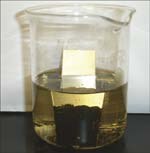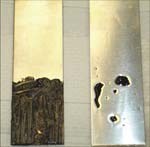Low-Vapor-Pressure Solvents Can Reduce VOC Emissions
Smog Alert!
Smog Alert! Ozone Action Day!
Until recently, most of us probably associated these terms with California, but their use has become more widespread as federal and state environmental regulators have become increasingly concerned with air quality.
Welcome! You’ve unlocked premium content.
This increased concern has led to a growing list of restrictions on air emissions. States are limiting the emission of Volatile Organic Compounds (VOCs) in their efforts to reduce smog and improve overall air quality. And, as more states enact tougher, wider-reaching regulations, companies selling cleaning products containing VOCs are forced to innovate to meet the new restrictions without compromising performance. One alternative that has shown promise is the utilization of low-vapor-pressure (LVP) solvents.
Regulations, Regulations
The 1990 Amendments to the U.S. Clean Air Act identified consumer and commercial products as sources of Volatile Organic Compound (VOC) emissions. In 1998, the U.S. EPA established the National Volatile Organic Compound Emissions Standards for Consumer Products. These standards also apply to industrial general-purpose cleaning and degreasing products.
Since 1998, several states have established expanded, and more exacting, standards regarding VOC emissions. Many of these state standards took effect on January 1, 2005. The trend toward more stringent state standards will no doubt continue.
Volatile Organic Compounds
VOCs are very effective at dissolving and removing oily, greasy soils, which is why they have traditionally been used in many cleaning solutions. Two of the most widely used VOCs in aqueous cleaning products are 2-butoxyethanol (Butyl Cellosolve) and d-Limonene. The cleaning performance of these substances is well-documented and beyond dispute; but, as already noted, products containing these solvents are facing more regulation and restriction by federal and state environmental agencies.
With each new regulation, companies are pressured to switch to environmentally friendly “green” cleaners, and this trend is influencing new cleaning product formulations. A large effort is now underway at many suppliers of cleaning chemicals to develop “no-VOC” technology to replace these conventional solvents without compromising degreasing performance.
Identifying Potential Alternatives
Our first step in this effort was to define the term VOC, to give us some criteria for screening potential raw materials. 40 CFR chapter 1, part 59, 59.203, part F defines VOCs, and outlines which compounds are and are not considered volatile. The pertinent part of the definition specifies that a compound is non-volatile if its vapor pressure is below 0.1 mm Hg at 20°C. The challenge, therefore, was to identify low-vapor-pressure (LVP) solvents that fit this definition and still provide the required degreasing power.
Testing Potential Alternatives
Technicians identified solvents fitting this definition, and began performance testing to characterize each solvent’s degreasing ability. The method consisted of soiling stainless steel panels with gear grease and weighing them on an analytical balance. The amount of grease and surface area exposed to the solvent on each panel was maintained as consistently as experimentally possible.
After being soiled and weighed, the panels were immersed in the test solvent for five minutes with no agitation, then removed and allowed to air-dry overnight. Once dry, the panels were reweighed and the percentage of grease removed calculated. Results were then compared with those obtained using Butyl Cellosolve and d-Limonene.
The candidate solvents outperformed Butyl Cellosolve but were unable to match the performance (90+% removal of grease) of d-Limonene. Because none of the solvents alone matched the performance of d-Limonene, the next step was to test some solvent blends. Two-component solvent blends were tested, but did not perform any better than the straight solvents.
As a final effort, some three-solvent blends were tested, and yielded a significant improvement in degreasing performance. The results were so surprising that tests were repeated multiple times for confirmation. The three-solvent blend represented on the graph removed almost 95% of the grease, performing better than d-Limonene.
Formulating a Final Product
Once we identified the synergistic degreasing performance of the patent-pending blend of LVP solvents, work began to incorporate the LVP solvent blend into a general-purpose cleaner. This task also entailed overcoming some daunting obstacles. For example, we found that one of the solvents degraded in water over time, and once degraded, its degreasing performance suffered significantly. Therefore a water-based product would have a significantly shortened shelf life.
On the other hand, LVP solvents are not water-soluble, so they could not simply be added to water at the point of use without emulsifiers. These factors required us to formulate a highly concentrated product that is almost 100% active with emulsifiers, thus enabling dilution with water at the point of use and ensuring an acceptable shelf life.
Solutions to these technical obstacles led to one additional obstacle: the high price per gallon of a concentrate compared to typical water-based general-purpose cleaning products. As always, success in overcoming this obstacle depends on the ability of sales personnel to explain, and prospective customers to understand, the need to consider the ultimate “use-cost” of a product versus the up-front cost per gallon.
In this case, the difference in the amount of product used offsets the difference in price. For example, the projected use concentration for the new LVP product is a 1% dilution, compared with the 5-10% use concentration typical of an industrial general-purpose cleaner. The bottom line is the LVP product, while priced more per gallon than a traditional general-purpose cleaner, provides superior cleaning, no VOCs, and ultimately costs about the same. Many industrial customers in the market for a general-purpose cleaner should find this compelling.
Conclusion
Chances are, VOC limits will continue to be lowered until they are zero. Given that assumption, instead of taking existing products and reducing their VOC levels to current allowances, our company took a zero-VOC approach to formulate new products utilizing LVP technology. As a result, we are now ahead of existing VOC regulations.
That being said, if a product doesn’t work, customers will not buy or use it, even if it does meet U.S. EPA and state VOC regulations. It has now been established that LVP solvents work. They are a viable alternative to traditional solvents, and, in fact, can outperform them in degreasing. The LVP solvent-blend product innovation path has been arduous, but has yielded some significant improvements. The no-VOC blend identified in this discussion allows a customer to use effective degreasing products without emitting VOCs to the air, thereby meeting and exceeding the new environmental regulations.
Related Content
Vacuum Degreaser Cleans Up a Messy Situation
By replacing its immersion parts washer with a vacuum degreasing system, this machine shop is much more efficient, saving the company money, man hours and the health of the operators.
Read MoreReplacing Open-Top Vapor Degreasing in Aerospace Manufacturing
Options and considerations for cleaning aerospace parts as regulations tighten on vapor degreasing solvents.
Read MoreMicroCare Offers Alternatives to Discontinued Vapor Degreasing Fluids
MicroCare says it is equipped to handle customers affected by 3M's discontinuation of the Novec specialty fluids line with its own products.
Read MoreTop Shop Emphasizes Dedication, Work Ethic
With a primary focus on aerospace and defense work, American Metaseal Corp. of Arbutus, Maryland, has qualified as a Top Shop on multiple occasions.
Read MoreRead Next
Episode 45: An Interview with Chandler Mancuso, MacDermid Envio Solutions
Chandler Mancuso, technical director with MacDermid Envio discusses updating your wastewater treatment system and implementing materials recycling solutions to increase efficiencies, control costs and reduce environmental impact.
Read MoreDelivering Increased Benefits to Greenhouse Films
Baystar's Borstar technology is helping customers deliver better, more reliable production methods to greenhouse agriculture.
Read MoreA ‘Clean’ Agenda Offers Unique Presentations in Chicago
The 2024 Parts Cleaning Conference, co-located with the International Manufacturing Technology Show, includes presentations by several speakers who are new to the conference and topics that have not been covered in past editions of this event.
Read More

























